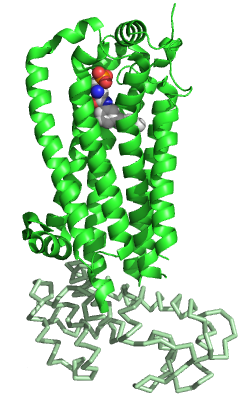S1PR1 (sfingozin-1-fosfatni receptor 1, S1P1, EDG1, endotelni diferencijacioni gen 1) je protein koji je kod ljudi kodiran S1PR1 genom. S1P1 je G protein spregnuti receptor za koji se vezuje lipidni signalni molekul sfingozin-1-fosfat (S1P).
Kratke činjenice Sfingozin-1-fosfatni receptor 1, Dostupne strukture ...
Zatvori
Ovaj protein je visoko izražen u endotelnim ćelijama. On vezuje sfingozin-1-fosfat sa visokim afinitetom i specifičnošću, i smatra se da učestvuje u procesima koji regulišu diferencijaciju endotelnih ćelija. Aktivacija ovog receptora indukuje međućelijsku adheziju.[2]
Hanson, M. A.; Roth, C. B.; Jo, E.; Griffith, M. T.; Scott, F. L.; Reinhart, G.; Desale, H.; Clemons, B. i dr.. (2012). „Crystal Structure of a Lipid G Protein-Coupled Receptor”. Science 335 (6070): 851. DOI:10.1126/science.1215904. Salim, Kamran; Fenton Tim, Bacha Jamil, Urien-Rodriguez Hector, Bonnert Tim, Skynner Heather A, Watts Emma, Kerby Julie, Heald Anne, Beer Margaret, McAllister George, Guest Paul C (May 2002). „Oligomerization of G-protein-coupled receptors shown by selective co-immunoprecipitation”. J. Biol. Chem. (United States) 277 (18): 15482–5. DOI:10.1074/jbc.M201539200. ISSN 0021-9258. PMID 11854302. Lee, M J; Evans M, Hla T (May 1996). „The inducible G protein-coupled receptor edg-1 signals via the G(i)/mitogen-activated protein kinase pathway”. J. Biol. Chem. (UNITED STATES) 271 (19): 11272–9. DOI:10.1074/jbc.271.19.11272. ISSN 0021-9258. PMID 8626678.
- Spiegel S (2000). „Sphingosine 1-phosphate: a ligand for the EDG-1 family of G-protein-coupled receptors.”. Ann. N. Y. Acad. Sci. 905: 54–60. DOI:10.1111/j.1749-6632.2000.tb06537.x. PMID 10818441.
- Igarashi Y (2002). „[Current studies on a novel lipid mediator, sphingosine 1-phosphate, and its receptors]”. Tanpakushitsu Kakusan Koso 47 (4 Suppl): 476–9. PMID 11915345.
- Takuwa Y (2002). „[Regulation of Rho family G proteins and cell motility by the Edg family of sphingosin 1-phosphate receptors]”. Tanpakushitsu Kakusan Koso 47 (4 Suppl): 496–502. PMID 11915348.
- Takuwa Y, Takuwa N, Sugimoto N (2003). „The Edg family G protein-coupled receptors for lysophospholipids: their signaling properties and biological activities.”. J. Biochem. 131 (6): 767–71. PMID 12038970.
- Wang D, Zhao Z, Caperell-Grant A,et al. (2008). „S1P differentially regulates migration of human ovarian cancer and human ovarian surface epithelial cells.”. Mol Cancer Ther 7 (7): 1993–2002. PMID 18645009.
- Hla T, Maciag T (1990). „An abundant transcript induced in differentiating human endothelial cells encodes a polypeptide with structural similarities to G-protein-coupled receptors.”. J. Biol. Chem. 265 (16): 9308–13. PMID 2160972.
- Lee MJ, Evans M, Hla T (1996). „The inducible G protein-coupled receptor edg-1 signals via the G(i)/mitogen-activated protein kinase pathway.”. J. Biol. Chem. 271 (19): 11272–9. DOI:10.1074/jbc.271.19.11272. PMID 8626678.
- Bonaldo MF, Lennon G, Soares MB (1997). „Normalization and subtraction: two approaches to facilitate gene discovery.”. Genome Res. 6 (9): 791–806. DOI:10.1101/gr.6.9.791. PMID 8889548.
- An S, Bleu T, Huang W, et al. (1998). „Identification of cDNAs encoding two G protein-coupled receptors for lysosphingolipids.”. FEBS Lett. 417 (3): 279–82. DOI:10.1016/S0014-5793(97)01301-X. PMID 9409733.
- Lee MJ, Van Brocklyn JR, Thangada S, et al. (1998). „Sphingosine-1-phosphate as a ligand for the G protein-coupled receptor EDG-1.”. Science 279 (5356): 1552–5. DOI:10.1126/science.279.5356.1552. PMID 9488656.
- Lee MJ, Thangada S, Liu CH, et al. (1998). „Lysophosphatidic acid stimulates the G-protein-coupled receptor EDG-1 as a low affinity agonist.”. J. Biol. Chem. 273 (34): 22105–12. DOI:10.1074/jbc.273.34.22105. PMID 9705355.
- Ancellin N, Hla T (1999). „Differential pharmacological properties and signal transduction of the sphingosine 1-phosphate receptors EDG-1, EDG-3, and EDG-5.”. J. Biol. Chem. 274 (27): 18997–9002. DOI:10.1074/jbc.274.27.18997. PMID 10383399.
- Windh RT, Lee MJ, Hla T, et al. (1999). „Differential coupling of the sphingosine 1-phosphate receptors Edg-1, Edg-3, and H218/Edg-5 to the G(i), G(q), and G(12) families of heterotrimeric G proteins.”. J. Biol. Chem. 274 (39): 27351–8. DOI:10.1074/jbc.274.39.27351. PMID 10488065.
- Lee MJ, Thangada S, Claffey KP, et al. (1999). „Vascular endothelial cell adherens junction assembly and morphogenesis induced by sphingosine-1-phosphate.”. Cell 99 (3): 301–12. DOI:10.1016/S0092-8674(00)81661-X. PMID 10555146.
- Igarashi J, Michel T (2000). „Agonist-modulated targeting of the EDG-1 receptor to plasmalemmal caveolae. eNOS activation by sphingosine 1-phosphate and the role of caveolin-1 in sphingolipid signal transduction.”. J. Biol. Chem. 275 (41): 32363–70. DOI:10.1074/jbc.M003075200. PMID 10921915.
- Parrill AL, Wang D, Bautista DL, et al. (2001). „Identification of Edg1 receptor residues that recognize sphingosine 1-phosphate.”. J. Biol. Chem. 275 (50): 39379–84. DOI:10.1074/jbc.M007680200. PMID 10982820.
- Liu Y, Wada R, Yamashita T, et al. (2000). „Edg-1, the G protein-coupled receptor for sphingosine-1-phosphate, is essential for vascular maturation.”. J. Clin. Invest. 106 (8): 951–61. DOI:10.1172/JCI10905. PMC 314347. PMID 11032855.
- Murphy WJ, Eizirik E, Johnson WE, et al. (2001). „Molecular phylogenetics and the origins of placental mammals.”. Nature 409 (6820): 614–8. DOI:10.1038/35054550. PMID 11214319.
- Hobson JP, Rosenfeldt HM, Barak LS, et al. (2001). „Role of the sphingosine-1-phosphate receptor EDG-1 in PDGF-induced cell motility.”. Science 291 (5509): 1800–3. DOI:10.1126/science.1057559. PMID 11230698.
- Lee MJ, Thangada S, Paik JH, et al. (2001). „Akt-mediated phosphorylation of the G protein-coupled receptor EDG-1 is required for endothelial cell chemotaxis.”. Mol. Cell 8 (3): 693–704. DOI:10.1016/S1097-2765(01)00324-0. PMID 11583630.

